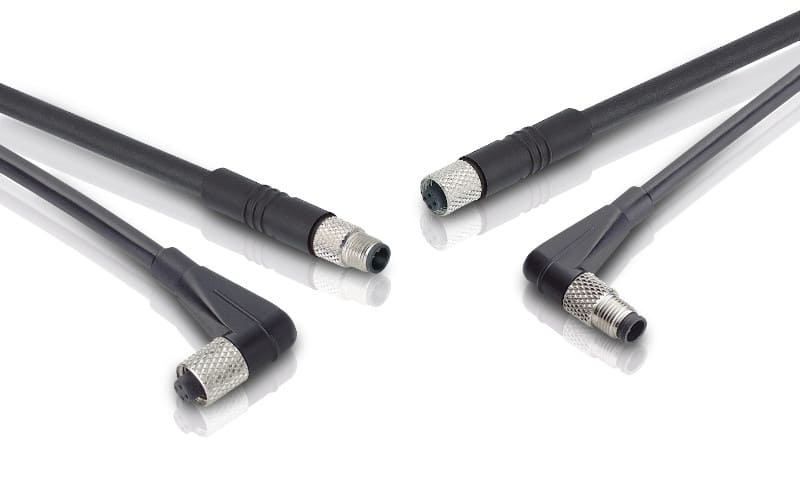Reliable signal transmission in electromagnetically exposed industrial environments requires sophisticated and comprehensive EMC concepts. By means of binder’s 360°-shielded M5 connectors, these can now also be implemented in miniaturized applications that have particularly little installation space available – for example in robotics, sensor technology, metrology, and analytics.
binder has complemented its M5 size portfolio with connectors featuring 360° shielding. The 707 series products are available in 3- and 4-pin versions, with both straight and angled cable outlets. The connectors are equipped with screw locking and standardized according to the design specification DIN EN 61076-2-105. They are particularly suitable for use under the influence of high-frequency electric and magnetic fields. Their 360° shielding enables shielding attenuation values of 60 dB at frequencies around 1 GHz.
Comprehensive shielding concept for automation solutions
The interference-free operation of sensitive electronic modules is a fundamental requirement in the field of automation technology. Machines and systems include high-frequency circuits, for example in switched-mode power supplies, which can affect the circuits of surrounding controllers with noise due to coupling effects. The signal paths of sensors and actuators are also subject to electromagnetic interference (EMI). Besides the automation components, shielding concepts that offer comprehensive EMI protection include the sensor-actuator cabling and all signal lines; they also extend to the electromechanical connectivity solutions, which must be integrated into the respective shielding concept.
As automation components continue to miniaturize, small, robust and flexible signal connectors are gaining in importance. Above all, the space-saving M5 size, equipped with screw locking, is suitable here as a reliable connection solution. The development of effective shielding for these particularly small connectors is very demanding, for example with regard to connecting the shield to the housing and in terms of mechanical robustness, e.g. under shock and vibration loads.
From sensors and metrology to cobots and drones
The M5 products of the binder 707 series have been subject to extensive laboratory tests, which confirm both the required shielding performance and the reliable function of the products under typical industrial loads. Their range of application extends from ultrasonic sensors and miniature valves to instrumentation and analytic devices. Further application examples can be found in signal transmission for cobots or in drones as well as in e-scooters and e-bikes.
Since binder is able to offer customer-specific variants of the shielded M5 connectors, their field of use can be quickly extended to new applications. Guido Werner, product manager at binder, comments, “As a result of the successful market launch, we have already received new concrete customer inquiries, based on which further M5 products are being developed.” By the end of this year, Werner said, there will be angled panel mount parts with dip solder contacts for PCB assembly; M5 variants that can be freely assembled in the field will also be available. “These additional connectors will complete our M5 product portfolio. There will then be overmolded cables, panel mount parts and field-wireable connectors in various designs in this size,” Werner continues. “This makes binder the first manufacturer worldwide to offer a complete product portfolio in this size.”
Parameters at a glance
The M5 circular connectors with screw locking and 360° shielding operate at a rated voltage of 60 V and a rated current of 1 A, and withstand surge voltages of up to 1500 V. Crimping and dip soldering are applied as termination techniques. Designed for use in industrial environments, the components meet the requirements of IP67 protection. Their operating temperature range extends from -25 °C to +80 °C, and they are designed for a mechanical service life of more than 100 mating cycles.

